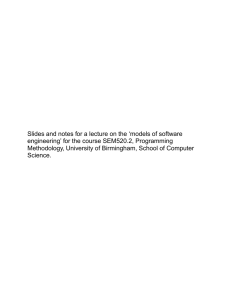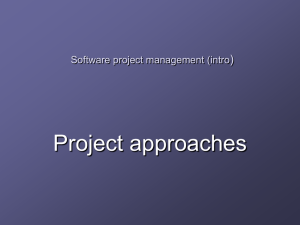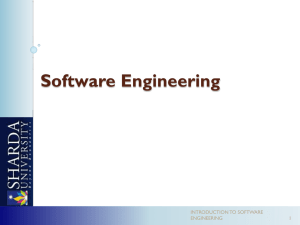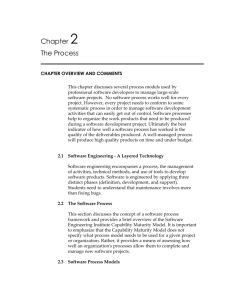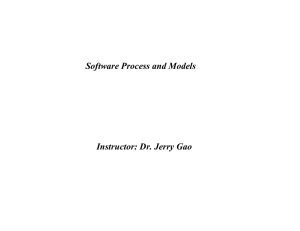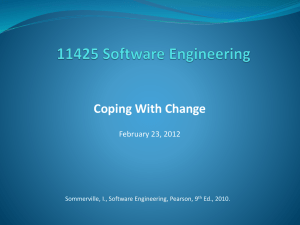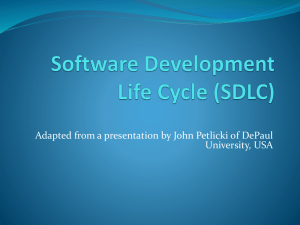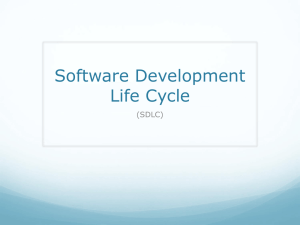The Spiral Model
advertisement
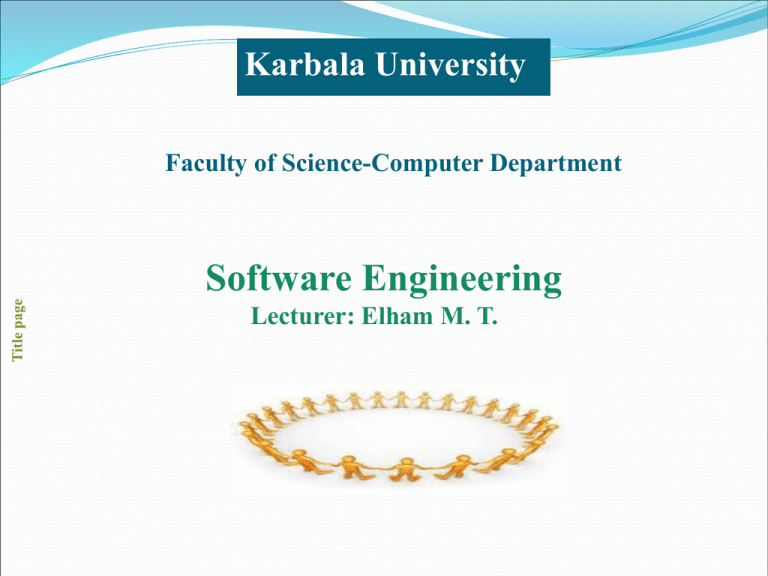
Karbala University Faculty of Science-Computer Department Software Engineering Lecturer: Elham M. T. Presentation outline Software Life Cycle Models Build and Fix Model Waterfall Model The Prototyping Model The Incremental Model The Spiral Model The Exploratory Model Software Life Cycle Models A software lifecycle model is a series of steps through which the product progresses. These include requirements phase, specification phase, design phase, implementation phase, integration phase, maintenance phase, and retirement. The list of models includes the following: 1- Build and Fix Model unfortunate that many products are developed using what is known as the build-and fix model In this model the product is constructed without specification or any attempt at design. The developers simply build a product that is reworked as many times as necessary to satisfy the client. This model may work for small projects but is totally unsatisfactory for products of any reasonable size. The cost of buildand fix is actually far greater than the cost of properly specified and carefully designed product. Maintenance of the product can be extremely in the absence of an\ documentation. This model is depicted in figure 1. It is Fig. 1: Build and Fix Model 2-Waterfall Model The first published model of the software development process was derived from other engineering processes. Because of the cascade from one phase to another, this model is known as the waterfall model. This model is also known as linear sequential model. This model is depicted in figure Fig. 2 Waterfall model It suggests a systematic, sequential approach to software development that begins at the system level and progresses through the analysis, design, coding, testing, and maintenance. The drawback of the waterfall model is the difficulty of accommodating change after the process is underway. The Waterfall model problems are: • Inflexible partitioning of the project into distinct stages. • This makes it difficult to respond to changing customer requirements. • Therefore, this model is only appropriate when the requirements are well-understood. 3- The Prototyping Model The prototyping Model begins with requirements gathering. Developer and customer meet and define the overall objectives for the software, identify whatever requirements arc known, and outline areas where further definition is 'mandatory. A "quick design" then occurs. The quick design focuses on a representation of those aspects of the software that will be visible to the customer/user (e.g., input approaches and output formats). The quick design leads to the construction of a prototype. This process is shown in figure 3. The prototype is evaluated by the customer/user and used to refine requirements for the software to be developed. Iteration occurs as the prototype is tuned to satisfy the needs of the customer, while at the same time enabling the developer to better understand what needs to be done. Fig. 3 Prototyping Model The Prototyping problems arc: 1. Users treat the prototype as the solution. 2. The developer often makes implementation compromises in order to get a prototype working quickly. 4- The Incremental Mode The incremental model combines elements of the linear sequential model with the iterative philosophy of prototyping. Referring to Figure 2.4, the incremental model applies linear sequences in a staggered fashion as calendar time progresses. Each linear sequence produces a deliverable "increment" of the software. For example, word-processing software developed using the incremental paradigm might deliver basic file management, editing, and document production functions in the first increment; more sophisticated editing and document production capabilities in the second increment; spelling and grammar checking in the third increment; and advanced page layout capability in the fourth increment. It should be noted that the process flow for any increment can incorporate the prototyping paradigm. When an incremental model is used, the first increment is often a core product. That is, basic requirements are addressed, but many supplementary features (some known, others unknown) remain undelivered. The core product is used by the customer. As a result of use and/or evaluation, a plan is developed for the next increment. The plan addresses the modification of the core product to better meet the needs of the customer and the delivery of additional features and functionality. This process is repeated following the delivery of each increment, until the complete product is produced. Fig.4 the Incremental Model 5- The Spiral Model The spiral model is an evolutionary software process model that couples the iterative nature of prototyping with the controlled and systematic aspects of the linear sequential model. It provides the potential for rapid development of incremental versions of the software. Using the spiral model software is developed in a series of incremental releases. During early iterations, the incremental release might be a paper model or prototype. During later iterations, increasingly more complete versions of the engineered system are produced. ‘A spiral model is divided into a number of framework activities, also called task regions. Typically, there are between three and six task regions. Figure 2.5 depicts a spiral model that contains six task regions: 1. Customer communication—tasks required to establish effective communication between developer and customer. 2. Planning—tasks required to define resources, timelines, and other project related information. 3. Risk analysis—tasks required to assess both technical and management risks. 4. Engineering—tasks required to build one or more representations of the application. 5. Construction and release—tasks required to construct, test, install, and provide user support (e.g., documentation and training). 6. Customer evaluation—tasks required to obtain customer feedback based on evaluation of the software representations created during the engineering stage and implemented during the installation stage. Figure 2.5 the Spiral Model Fig.5 the Spiral Model Each of the regions is populated by a set of work tasks, called a task set, that are adapted tothe characteristics of the project to be undertaken. For small projects, the number of work tasks and their formality is low. For larger, more critical projects, each task region contains more work tasks that are defined to achieve a higher level of formality. 6- The Exploratory Model The Exploratory- model, shown in figure 2.6, is extremely simple in its construction; it is composed of the following steps: 1. Initial Specification Development: using whatever information is immediately available, a brief system specification is created to provide a rudimentary starting point. 2. System Construction / Modification (System Build): a system is created and / or modified according to whatever information is available. 3. System Testing: the system is tested to see what it does, what can be learned from it, and how it may be improved. 4. System Implementation (Delivery): after many iterations of the previous two steps produce satisfactory results, the system is dubbed as "finished" and implemented. This model is used in some situation in which it is very difficult, if not impossible, to identify any of the requirements for a system at the beginning of the project. Theoretical areas such as Artificial Intelligence are candidate for using the Exploratory model, because much of the research in these areas is based on guess-work, estimation and hypothesis. In These cases, an assumption is made as to how the system might work and then rapid iterations are used to quickly incorporate suggested changes and build a usable system. A distinguishing characteristic of the Exploratory model is the absence of precise specifications. Finishing project is based on the end result and not on its requirements. Fig. 6 Exploratory Model
